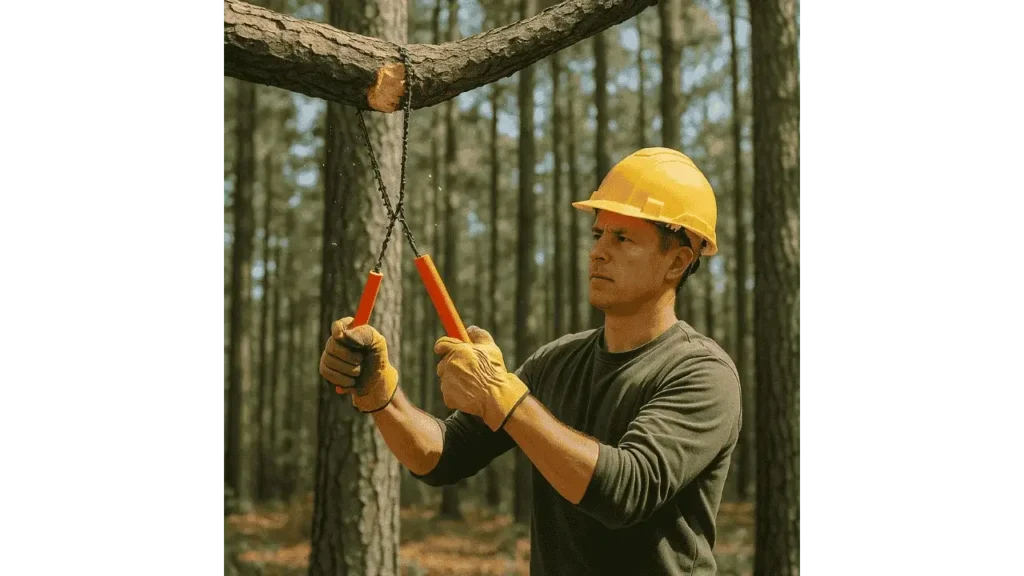Rope chainsaws might seem like a strange alternative to gas or electric chainsaws, but I can guarantee that they offer a surprisingly efficient and safer solution for specific pruning tasks. They are very often used by homeowners, gardeners, and campers; these compact tools use a simple pull-motion system to cut through high branches without the need for ladders or electricity.
“Many people underestimate them, but a rope chainsaw can be incredibly effective when used properly,” says Trevor Langston, a certified arborist from Pine Grove Tree Service.
What Is a Rope Chainsaw and How Does It Function?
A rope chainsaw is a flexible chain with cutting teeth, similar to a standard chainsaw chain, but without a motor. Each end of the chain has a rope attached. To use it, you throw the chain over a high branch, position the teeth where you want to cut, and pull the ropes back and forth. This manual sawing motion cuts through the branch from the ground. It’s a simple tool that relies on your effort rather than mechanical power.
Practical Uses of Rope Chainsaws
Rope chainsaws are ideal for trimming overhead limbs without climbing or using heavy equipment. They’re especially useful in tight spaces or dense tree lines where maneuvering a traditional chainsaw isn’t practical. Campers also carry them for trail clearing or firewood collection. Since they don’t require fuel or electricity, they’re reliable even in remote settings. The convenience of being lightweight and easily portable adds to their appeal.
Do Rope Chainsaws Actually Work?
Yes, they do; but within their limitations. Rope chainsaws are highly effective on branches up to 8 to 10 inches thick, particularly when the wood is dry and not too dense. However, the cutting speed depends on your strength and rhythm. On very hard or thick limbs, it can become tiring and less efficient than powered tools. Still, for moderate pruning jobs, they perform reliably.
“They’re a great backup tool, especially when you’re working solo or without power sources,” notes Linda Rawls, a forest management consultant.
Advantages of Rope Chainsaws
One of the main benefits is safety. Since you operate the tool from the ground, there’s no need for ladders or climbing; significantly reducing the risk of falls. They’re also inexpensive and easy to store. Unlike gas or electric chainsaws, rope versions are virtually silent and maintenance-free, making them ideal for occasional users who want a hassle-free solution. Additionally, they don’t produce emissions, which makes them eco-friendlier in comparison to fuel-powered saws.
Limitations to Consider
Despite their utility, rope chainsaws have downsides. They require upper body strength and coordination, especially when used for prolonged periods. Tangling is another common issue; if the rope or chain twists while thrown, it can take time to reposition. These saws aren’t suitable for cutting thick trunks or for professional forestry tasks. You’ll also find it tricky to control the cut’s direction or precision in crowded branches.
Tips for Safe and Efficient Use
To get the most out of a rope chainsaw, practice throwing and positioning it properly. Always wear gloves and safety goggles to protect yourself from falling debris. Start with smaller, lower branches to build confidence and control. Ensure the chain teeth face the right direction before sawing. Keeping the chain clean and occasionally lubricated can improve cutting performance.
Expert Opinions and Customer Experiences
Experts agree that rope chainsaws are not a one-size-fits-all tool, but they fill a valuable niche. Gardeners appreciate their simplicity and portability, while hikers find them useful for emergencies. Customers often praise their ability to trim branches that would otherwise be inaccessible without climbing.
“For quick pruning or storm cleanup, I always keep one in the truck; it’s saved me more than once,” says Mason Greene, a property maintenance contractor.
Final Takeaways
Rope chainsaws do work, and they work well within the right context. They’re best suited for light to moderate pruning jobs, especially when safety, portability, and independence from power tools are a priority. While they’re not built for heavy-duty logging or precise cuts, they offer a dependable alternative for specific outdoor tasks. If you know their strengths and limitations, a rope chainsaw can be a surprisingly useful addition to your tool collection.
- How to Cut a Straight Line with a Jigsaw? - October 31, 2025
- How to Cut a Circle with a Jigsaw? - October 31, 2025
- Can You Cut Acrylic with a Jigsaw? - October 31, 2025
